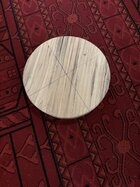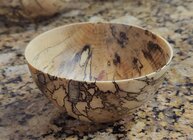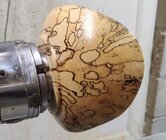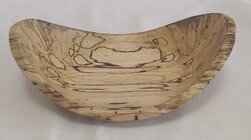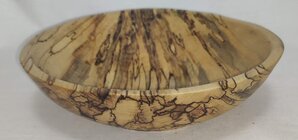Does anyone know where I can find or purchase spalted beech? I have searched the internet and can't seem to find a source. It seems to be very hard to find.
-
December 2025 Turning Challenge: Single Tree! (click here for details) -
Congratulations to Bob Henrickson, People's Choice in the November 2025 Turning Challenge (click here for details) -
Congratulations to Guillaume Fontaine for "Old Tea Pot" being selected as Turning of the Week for December 15, 2025 (click here for details) -
Welcome new registering member. Your username must be your real First and Last name (for example: John Doe). "Screen names" and "handles" are not allowed and your registration will be deleted if you don't use your real name. Also, do not use all caps nor all lower case.
You are using an out of date browser. It may not display this or other websites correctly.
You should upgrade or use an alternative browser.
You should upgrade or use an alternative browser.
Spalted Beech Wood?
- Thread starter Gabriel Hoff
- Start date
It would have helped if you mentioned the size you want, but there is some on Etsy. https://www.etsy.com/listing/1786434199/560-spalted-beech-block-lovely-spalted?ga_order=most_relevant&ga_search_type=all&ga_view_type=gallery&ga_search_query=spalted+beech&ref=sr_gallery-1-21&content_source=b7ffa8956c8a68d9f8ca2dcbee757d24e1775278%3A1786434199&search_preloaded_img=1&organic_search_click=1
and eBay, https://www.ebay.com/itm/256522303176?_skw=spalted+beech+bowl+blank&itmmeta=01J8EMPD58Q46V2EG2RQHYJMZJ&hash=item3bb9ebb6c8:g:QFkAAOSw3YBmUNSh&itmprp=enc:AQAJAAAA0HoV3kP08IDx+KZ9MfhVJKlwY0TRH7bdDx00qnfeN+B9S9PYIIPYrwF0H1jpT/6kON7w3frcwA1Nad4QkZ+q1EsmwKWT7iSVreUq7JIGbvKiL/hxIougGIQEYwIqjRNmGPq8h49TnwjBlGrrtpGU/g+qAfW/v9BdUpPKn7dq39Vw6OjdVV7WjKixA/zF0ggS2rICHST/Ou0McESx2IuXO3HRWZx+Xb6iOaWoD1iMvN3b4nwrggxl2BaXCGoBz4xkI1ik7T8Nr7vJa1tiYVt9FFA=|tkp:Bk9SR97S2dTDZA
and eBay, https://www.ebay.com/itm/256522303176?_skw=spalted+beech+bowl+blank&itmmeta=01J8EMPD58Q46V2EG2RQHYJMZJ&hash=item3bb9ebb6c8:g:QFkAAOSw3YBmUNSh&itmprp=enc:AQAJAAAA0HoV3kP08IDx+KZ9MfhVJKlwY0TRH7bdDx00qnfeN+B9S9PYIIPYrwF0H1jpT/6kON7w3frcwA1Nad4QkZ+q1EsmwKWT7iSVreUq7JIGbvKiL/hxIougGIQEYwIqjRNmGPq8h49TnwjBlGrrtpGU/g+qAfW/v9BdUpPKn7dq39Vw6OjdVV7WjKixA/zF0ggS2rICHST/Ou0McESx2IuXO3HRWZx+Xb6iOaWoD1iMvN3b4nwrggxl2BaXCGoBz4xkI1ik7T8Nr7vJa1tiYVt9FFA=|tkp:Bk9SR97S2dTDZA
Last edited:
Size would be 2" x 2" or larger. Those are definitely on the right track. Thanks!
Try Wood Barter.com
Most times I can find whatever I need or don"t need
Most times I can find whatever I need or don"t need
I second this. I've purchased several 15x15x4 spalted beech bowl blanks from a member of the site in Virginia.Try Wood Barter.com
Most times I can find whatever I need or don"t need
I'll keep my eyes open as I split wood for winter. I split one yesterday that wasn't really spalted, but had some pretty cool curly figure. I set a big chunck of it aside for turning.
Sorry, I can't answer your question.Does anyone know where I can find or purchase spalted beech? I have searched the internet and can't seem to find a source. It seems to be very hard to find.
But if you come visit, I'm gonna hide my stash! Actually, I might give you a piece. I keep one shelf with just spalted blanks.
One option for the long run is to start your own "spalting farm". A guy on another forum once wrote about how he does this. He cuts log sections maybe 3' long and stands a bumch of them on end in bare dirt. Every so many months (I forget, maybe four or six?) he examines them and cuts a few inches off the end looking for signs of spalting. At some point he gambles on the extent of the spalting and cuts one in half - if it's spalted in the middle the others probably are as well.. I've thought many times about trying this but never did. I have found some incredible spalting by chance.
Once a neighbor asked me to dig up a stump in her yard (I have an excavator). Turned out to be dogwood, one of my favorites anyway, and it was incredibly spalted. I love turning dogwood but that was the first spalted dogwood I ever found.
There is plenty information on the subject. Dr. Seri Robinson, sometimes called "Doctor Spalt" wrote a very interesting book, describing, among other things, which fungi result in particular colors. (I got a copy from Amazon) https://www.amazon.com/Spalting-101-Ultimate-Guide-Coloring/dp/0764360892
The most beautiful spalting I ever had I made accidentally. I was turning turning a wet chunk of wood round and put it in a plastic bag to keep it wet overnight. I forgot about and found it a few years later when moving my turning stuff from the garage to my new shop, completely dry and covered all over with a thick layer of fungus. Oh no! I cut into it anyway and discovered the most wonderful colors and black defense lines. Here is an egg I turned from a piece of it, some a wonderful green, some red. (was white wood, I forget, maybe beech, maybe maple.)
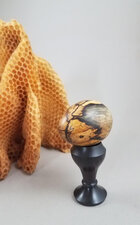
The egg was just a small piece from the accidental spalting experiment. The wood looked so interesting, though, I'm trying to duplicate it. I have several blocks of extra wet wood in wrapped tightly in plastic bags in a warm area (the insulated closet that houses my dust collector and air compressor.) It's probably about time to open one and take a look!
Since spalting is sort of dynamically spreading areas of rot, parts are often soft and punky. I've rescued several of these by soaking with thin CA - on one big bowl I used two bottles.
BTW, in case anyone doesn't know - (according to Dr. Spalt) the black lines we love so much are not actually the spalting but are called zone lines. The areas between the lines comprise the spalting, the areas where the fungus advances, consuming everything it comes to and sometimes leaving colors. Where two colonies of fungus meet they go to war and put up barriers so the other side can't invade their territory. These barriers are the black lines - If you ever examined some wide ones you might discover they are harder than the surrounding wood. The funny thing is a single colony of fungi can send off a side wing, which if they meet up later, don't recognize each other as part of the family and treat them as enemies! Fascinating.
JKJ
Wow! A lot of cool info there John. Your work seems really amazing, do you have any other pieces made from spalted beech. BTW I did find a source, from England!Sorry, I can't answer your question.
But if you come visit, I'm gonna hide my stash! Actually, I might give you a piece. I keep one shelf with just spalted blanks.
One option for the long run is to start your own "spalting farm". A guy on another forum once wrote about how he does this. He cuts log sections maybe 3' long and stands a bumch of them on end in bare dirt. Every so many months (I forget, maybe four or six?) he examines them and cuts a few inches off the end looking for signs of spalting. At some point he gambles on the extent of the spalting and cuts one in half - if it's spalted in the middle the others probably are as well.. I've thought many times about trying this but never did. I have found some incredible spalting by chance.
Once a neighbor asked me to dig up a stump in her yard (I have an excavator). Turned out to be dogwood, one of my favorites anyway, and it was incredibly spalted. I love turning dogwood but that was the first spalted dogwood I ever found.
There is plenty information on the subject. Dr. Seri Robinson, sometimes called "Doctor Spalt" wrote a very interesting book, describing, among other things, which fungi result in particular colors. (I got a copy from Amazon) https://www.amazon.com/Spalting-101-Ultimate-Guide-Coloring/dp/0764360892
The most beautiful spalting I ever had I made accidentally. I was turning turning a wet chunk of wood round and put it in a plastic bag to keep it wet overnight. I forgot about and found it a few years later when moving my turning stuff from the garage to my new shop, completely dry and covered all over with a thick layer of fungus. Oh no! I cut into it anyway and discovered the most wonderful colors and black defense lines. Here is an egg I turned from a piece of it, some a wonderful green, some red. (was white wood, I forget, maybe beech, maybe maple.)
View attachment 67130
The egg was just a small piece from the accidental spalting experiment. The wood looked so interesting, though, I'm trying to duplicate it. I have several blocks of extra wet wood in wrapped tightly in plastic bags in a warm area (the insulated closet that houses my dust collector and air compressor.) It's probably about time to open one and take a look!
Since spalting is sort of dynamically spreading areas of rot, parts are often soft and punky. I've rescued several of these by soaking with thin CA - on one big bowl I used two bottles.
BTW, in case anyone doesn't know - (according to Dr. Spalt) the black lines we love so much are not actually the spalting but are called zone lines. The areas between the lines comprise the spalting, the areas where the fungus advances, consuming everything it comes to and sometimes leaving colors. Where two colonies of fungus meet they go to war and put up barriers so the other side can't invade their territory. These barriers are the black lines - If you ever examined some wide ones you might discover they are harder than the surrounding wood. The funny thing is a single colony of fungi can send off a side wing, which if they meet up later, don't recognize each other as part of the family and treat them as enemies! Fascinating.
JKJ
Very nice pieces!
I've got a shelf full of wonderful spalted hackberry. Some tree guys told a friend once that hackberry trees are worthless, no good for firewood, boards, nothing. I beg to differ.
A few years ago I had one removed near the side of my shop; about 26" in dia. at 3' from the ground. Got some blocks drying, but I forgot about trying to spalt some. Oh, well, there are plenty more around the farm - they grow like weeds.
Have you seen "rainbow" poplar, yellow poplar that was struck by lightning? - some wonderful black and color in that.
Just took down a bunch of persimmon that were covering the driveway with their fruit in one spot. I've never seen spalted persimmon. Worth trying for? (For those who aren't familiar, persimmon is also called White Ebony and American Ebony - has the density and fine grain of ebony, great to turn. Warps like crazy as it dries - I cut it up into square turning blanks and they are soon diamond/rhobus shaped. Ebony-black heartwood is often only a pencil's diameter at the pith. https://www.wood-database.com/persimmon/
We have lots of box elder here too - I'm not a fan.
One of my favorite local woods is Eastern Red Cedar. Turns wonderfully, easy to get a very smooth surface.
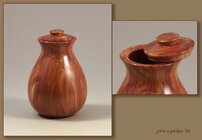
JKJ
I've got a shelf full of wonderful spalted hackberry. Some tree guys told a friend once that hackberry trees are worthless, no good for firewood, boards, nothing. I beg to differ.
A few years ago I had one removed near the side of my shop; about 26" in dia. at 3' from the ground. Got some blocks drying, but I forgot about trying to spalt some. Oh, well, there are plenty more around the farm - they grow like weeds.
Have you seen "rainbow" poplar, yellow poplar that was struck by lightning? - some wonderful black and color in that.
Just took down a bunch of persimmon that were covering the driveway with their fruit in one spot. I've never seen spalted persimmon. Worth trying for? (For those who aren't familiar, persimmon is also called White Ebony and American Ebony - has the density and fine grain of ebony, great to turn. Warps like crazy as it dries - I cut it up into square turning blanks and they are soon diamond/rhobus shaped. Ebony-black heartwood is often only a pencil's diameter at the pith. https://www.wood-database.com/persimmon/
We have lots of box elder here too - I'm not a fan.
One of my favorite local woods is Eastern Red Cedar. Turns wonderfully, easy to get a very smooth surface.

JKJ
Last edited:
Yes, the hack/sugarberry grow like weeds here.
I have yet to cut down a decent persimmon. I have two big ones in the back, about 100 yards into the forest. I hesitate to cut either of those down because persimmons are great deer food (OTOH we have too many deer as it is). The one I did cut down was small and dead, and the wood was just an ugly gray.
Some of my biggest trees are tulip trees (sometimes called poplar, although they are in the magnolia family). I have yet to cut one down. Frankly, they are big enough to intimidate me a bit.
I have quite a bit of ERC. I just noticed two dead ones near the road that I can harvest. They aren't big, maybe 12" and 20 ft. of usable wood.
Edit: I have cut down one smallish (10") box elder. It was pretty punky for the first 2-3'.
I have yet to cut down a decent persimmon. I have two big ones in the back, about 100 yards into the forest. I hesitate to cut either of those down because persimmons are great deer food (OTOH we have too many deer as it is). The one I did cut down was small and dead, and the wood was just an ugly gray.
Some of my biggest trees are tulip trees (sometimes called poplar, although they are in the magnolia family). I have yet to cut one down. Frankly, they are big enough to intimidate me a bit.
I have quite a bit of ERC. I just noticed two dead ones near the road that I can harvest. They aren't big, maybe 12" and 20 ft. of usable wood.
Edit: I have cut down one smallish (10") box elder. It was pretty punky for the first 2-3'.
The persimmons we had to take down were 10-12". I did have one about 18" that came down in a storm.Yes, the hack/sugarberry grow like weeds here.
I have yet to cut down a decent persimmon. I have two big ones in the back, about 100 yards into the forest. I hesitate to cut either of those down because persimmons are great deer food (OTOH we have too many deer as it is). The one I did cut down was small and dead, and the wood was just an ugly gray.
Some of my biggest trees are tulip trees (sometimes called poplar, although they are in the magnolia family). I have yet to cut one down. Frankly, they are big enough to intimidate me a bit.
I have quite a bit of ERC. I just noticed two dead ones near the road that I can harvest. They aren't big, maybe 12" and 20 ft. of usable wood.
Edit: I have cut down one smallish (10") box elder. It was pretty punky for the first 2-3'.
The most common tree in our area of TN is also the yellow poplar. I have several that are in excess of 10' in diameter. We do have a lot of maple, cherry, walnut, box elder, hackberry, black locust, sourwood, sassafras, and more, some are huge. I don't have many big cedar but wouldn't cut them anyway. Sometimes people will bring me big cedar logs and I saw slabs or blocks - I have a sawmill behind the barn.
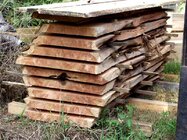
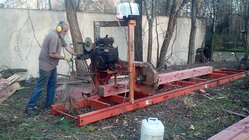
I can easily take down large pine trees with the excavator, but the big oaks and poplar I call a guy with a truck. We have a deal - he cuts the trees, I clean up all the wood and branches. It's a cheaper that way.
If I remember correctly, this pine was almost 30" in diameter. I first dug a hole about 6' in dia and over 4' deep then pushed. If it wasn't already leaning in the direction I wanted it to go I would have never tried it! I've taken down dozens like this, many 100' or more high. Often when taking down trees of any type I'll put a long rope through a pulley and pull with the skid steer while pushing (or while someone is sawing). I'd like to get rid of each of the 100s of big pine on our property. They are all virginia "scrub" pine.
JKJ
I have yet to find any sourwood on my place. @Michael Anderson and I were discussing recently. I don't THINK I have any, but I'll keep an eye out.
I wish I had an excavator, but I just can't justify it. I ran heavy equipment for my dad in my teens and I'd like to get back in the seat. I also really wish I had a mill! A used one could probably be had for $2k or less.
I wish I had an excavator, but I just can't justify it. I ran heavy equipment for my dad in my teens and I'd like to get back in the seat. I also really wish I had a mill! A used one could probably be had for $2k or less.
Since I don't borrow money for anything, I saved 10 years for the excavator. I can't begin to describe how useful it is around our property (and to help the neighbors a time or two). Really great for cleaning up when I have trees cut or if nature brings them down - things I would take so much effort but hand, if even possible.I wish I had an excavator, but I just can't justify it. I ran heavy equipment for my dad in my teens and I'd like to get back in the seat. I also really wish I had a mill! A used one could probably be had for $2k or less.
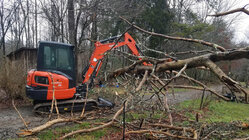
I had an old wheeled JD skid steer but it was starting to run down so I was beginning to scope out the Kubota tracked loader/skid steers. It would take me a long time to save for one but suddenly one became available and they offered it to me for 0% interest! That was more temptation than I could resist. Like the other machine, now I'd hate to be without it. Between those two machines and the tractor I can do just about anything I can imagine (related to trees, dirt, and rocks, that is!)
And find a good deal on a dump trailer - whoa, hold me back!
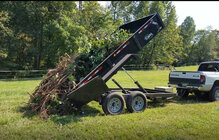
The skid steer is a beast. Dig out and move huge stumps, cut roads, move big rocks. Then I got a grapple and everything changed again - trees, huge piles of brush and limbs, rocks, makes life on the farm easier. And great fun!
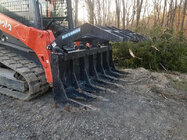
And friends like to try their hand. Hard to believe it, but there are guys and girls out there who have never operated such equipment!
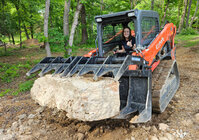
The mill as been handy over the last 20 years, but I'm not using it as much now. Might be about time to pass it to someone else.
I have yet to find any sourwood on my place. @Michael Anderson and I were discussing recently. I don't THINK I have any, but I'll keep an eye out.
I've gotten to where I can spot them in the woods from the bark, but I used to watch for the flowers. They are everywhere around here. I have beehives here and there is a market for sourwood honey, but I have never seen a bee in any of mine, even with binoculars. The beekeepers I know that go after sourwood honey load up hives on trailers and take them up in the mountains for a spell.
I do have one sourwood that's smack in the middle of a track through the woods that I've been considering taking down so I can more easily get a tractor pulling a trailer through there. I understand the wood can look nice.
JKJ
Really sweet equipment John!!Since I don't borrow money for anything, I saved 10 years for the excavator. I can't begin to describe how useful it is around our property (and to help the neighbors a time or two). Really great for cleaning up when I have trees cut or if nature brings them down - things I would take so much effort but hand, if even possible.
View attachment 67292
I had an old wheeled JD skid steer but it was starting to run down so I was beginning to scope out the Kubota tracked loader/skid steers. It would take me a long time to save for one but suddenly one became available and they offered it to me for 0% interest! That was more temptation than I could resist. Like the other machine, now I'd hate to be without it. Between those two machines and the tractor I can do just about anything I can imagine (related to trees, dirt, and rocks, that is!)
And find a good deal on a dump trailer - whoa, hold me back!
View attachment 67293
The skid steer is a beast. Dig out and move huge stumps, cut roads, move big rocks. Then I got a grapple and everything changed again - trees, huge piles of brush and limbs, rocks, makes life on the farm easier. And great fun!
View attachment 67290
And friends like to try their hand. Hard to believe it, but there are guys and girls out there who have never operated such equipment!
View attachment 67291
The mill as been handy over the last 20 years, but I'm not using it as much now. Might be about time to pass it to someone else.
I've gotten to where I can spot them in the woods from the bark, but I used to watch for the flowers. They are everywhere around here. I have beehives here and there is a market for sourwood honey, but I have never seen a bee in any of mine, even with binoculars. The beekeepers I know that go after sourwood honey load up hives on trailers and take them up in the mountains for a spell.
I do have one sourwood that's smack in the middle of a track through the woods that I've been considering taking down so I can more easily get a tractor pulling a trailer through there. I understand the wood can look nice.
JKJ

